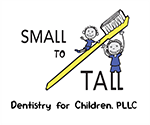Clean the area of the affected tooth. Rinse the mouth thoroughly with warm water or use dental floss to dislodge any food that may be impacted. Give your child Tylenol or Motrin for pain relief. If the pain persists after a couple of hours, contact your child’s dentist. Do not place aspirin or heat on the gum or on the aching tooth. If the face is swollen apply cold compresses to the affected side of the face and contact your dentist immediately.
If there is bleeding apply firm but gentle pressure with a cold wet washcloth or paper towel. It may take 20 or 30 minutes to control the bleeding, since the mouth is very vascular. If bleeding cannot be controlled by simple pressure, or the edges of the cut area will not lie flat together, call your pediatrician or visit the hospital emergency room.
If possible, find the tooth. Handle it by the crown, not by the root. You may rinse the tooth with tepid water only. DO NOT clean with soap, scrub or handle the tooth unnecessarily. Inspect the tooth for fractures. Rinse the mouth with warm salt water. If the tooth appears to be intact, try to reinsert it in the socket. Have the patient hold the tooth in place by biting on washcloth or pad of paper towel. If you cannot reinsert the tooth, transport the tooth in a cup containing the patient’s saliva or cold milk. The patient must see a dentist IMMEDIATELY! Time is a critical factor in saving the tooth.
Control bleeding by applying pressure with a cold wet washcloth or paper towel. Locate the tooth to confirm that it is knocked out and not pushed up into the gum. It is not advisable to replant a baby tooth. If you cannot locate the tooth you should contact your dentist during office hours to obtain an X-ray to see if the tooth has been intruded.
In most cases the tooth will grow back down into the mouth over time. If a baby tooth does not re-erupt by 12 months after the injury, it is advisable to have it removed so that it does not interfere with the development of the permanent tooth. If a permanent tooth does not re-erupt after a few months, it is advisable to begin orthodontic care to move it back into position.
Rinse the mouth with warm water and if possible, locate and save any broken tooth fragments and bring them with you to the dentist. Transport them in a ziplock bag with a few drops of water to prevent dehydration of the tooth pieces. If your child is not in pain, and only the outer edge of enamel has chipped, you can see the dentist during normal office hours. If the dentin is exposed your child will be in more pain and will need palliative treatment to cover the exposed edge of the dentin. If the cut edge of the tooth is pink, red and/or bleeding your child needs immediate care to begin root canal treatment. A baby tooth may need to be extracted of the nerve exposure is severe.
Take your child to the nearest hospital emergency room immediately.
Keep the jaw from moving and take your child to the nearest hospital emergency room.
